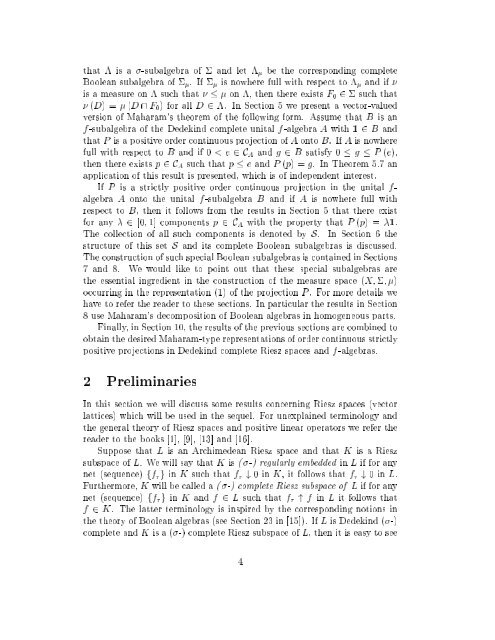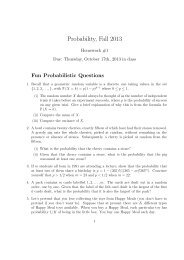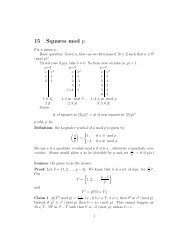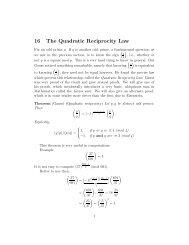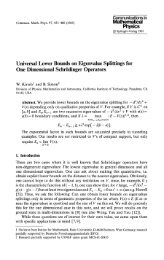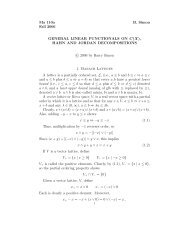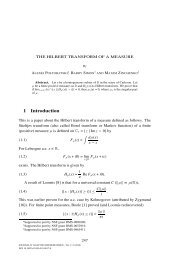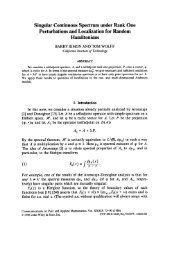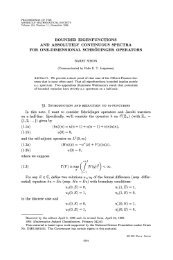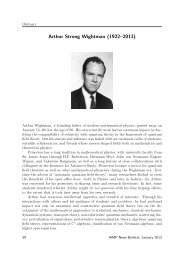Representations of positive projections 1 Introduction - Mathematics ...
Representations of positive projections 1 Introduction - Mathematics ...
Representations of positive projections 1 Introduction - Mathematics ...
Create successful ePaper yourself
Turn your PDF publications into a flip-book with our unique Google optimized e-Paper software.
that is a -subalgebra <strong>of</strong> and let be the corresponding complete<br />
Boolean subalgebra <strong>of</strong> . If is nowhere full with respect to and if<br />
is a measure on such that on , then there exists F 0 2 such that<br />
(D) = (D \ F 0) for all D 2 . In Section 5 we present a vector-valued<br />
version <strong>of</strong> Maharam's theorem <strong>of</strong> the following form. Assume that B is an<br />
f-subalgebra <strong>of</strong> the Dedekind complete unital f-algebra A with 1 2 B and<br />
that P is a <strong>positive</strong> order continuous projection <strong>of</strong> A onto B. If A is nowhere<br />
full with respect to B and if 0 < e 2 CA and g 2 B satisfy 0 g P (e),<br />
then there exists p 2CA such that p e and P (p) =g. In Theorem 5.7 an<br />
application <strong>of</strong> this result is presented, which is <strong>of</strong> independent interest.<br />
If P is a strictly <strong>positive</strong> order continuous projection in the unital falgebra<br />
A onto the unital f-subalgebra B and if A is nowhere full with<br />
respect to B, then it follows from the results in Section 5 that there exist<br />
for any 2 [0 1] components p 2 CA with the property that P (p) = 1.<br />
The collection <strong>of</strong> all such components is denoted by S. In Section 6 the<br />
structure <strong>of</strong> this set S and its complete Boolean subalgebras is discussed.<br />
The construction <strong>of</strong> such special Boolean subalgebras is contained in Sections<br />
7 and 8. We would like to point out that these special subalgebras are<br />
the essential ingredient in the construction <strong>of</strong> the measure space (X )<br />
occurring in the representation (1) <strong>of</strong> the projection P . For more details we<br />
have to refer the reader to these sections. In particular the results in Section<br />
8 use Maharam's decomposition <strong>of</strong> Boolean algebras in homogeneous parts.<br />
Finally, in Section 10, the results <strong>of</strong> the previous sections are combined to<br />
obtain the desired Maharam-type representations <strong>of</strong> order continuous strictly<br />
<strong>positive</strong> <strong>projections</strong> in Dedekind complete Riesz spaces and f-algebras.<br />
2 Preliminaries<br />
In this section we will discuss some results concerning Riesz spaces (vector<br />
lattices) which will be used in the sequel. For unexplained terminology and<br />
the general theory <strong>of</strong> Riesz spaces and <strong>positive</strong> linear operators we refer the<br />
reader to the books [1], [9], [13] and [16].<br />
Suppose that L is an Archimedean Riesz space and that K is a Riesz<br />
subspace <strong>of</strong> L. We will say thatK is ( -) regularly embedded in L if for any<br />
net (sequence) ff g in K such that f # 0 in K, it follows that f # 0 in L.<br />
Furthermore, K will be called a ( -) complete Riesz subspace <strong>of</strong> L if for any<br />
net (sequence) ff g in K and f 2 L such that f " f in L it follows that<br />
f 2 K. The latter terminology is inspired by the corresponding notions in<br />
the theory <strong>of</strong> Boolean algebras (see Section 23 in [15]). If L is Dedekind ( -)<br />
complete and K is a ( -) complete Riesz subspace <strong>of</strong> L, then it is easy to see<br />
4


